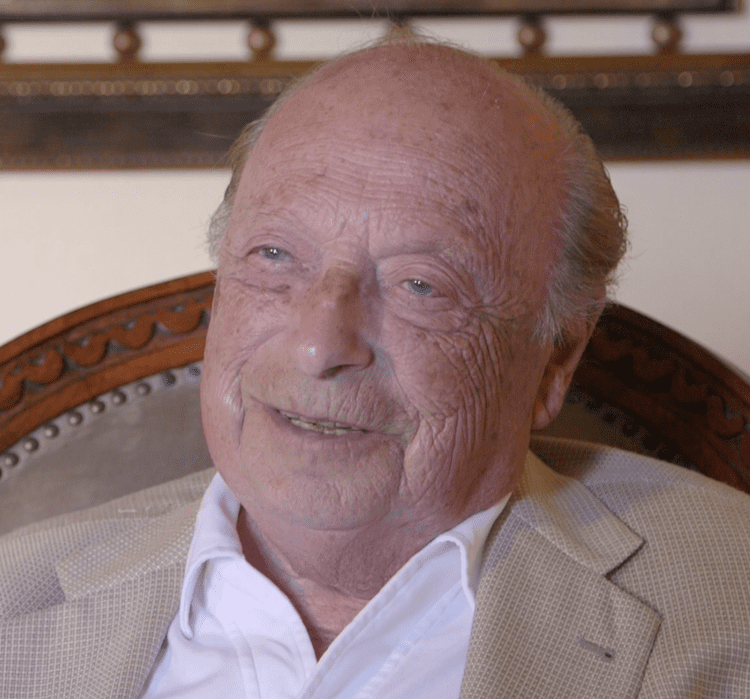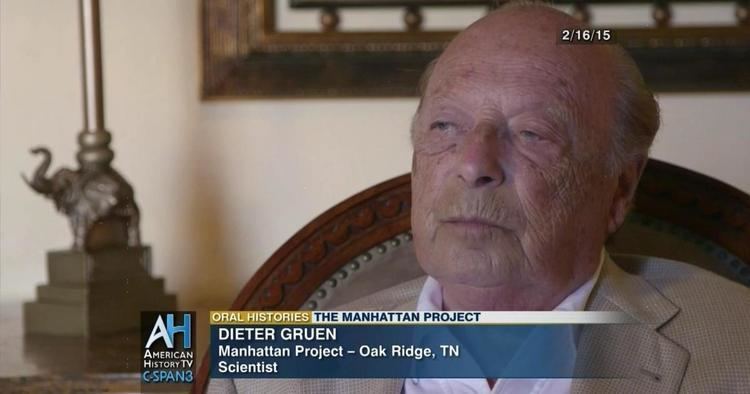Name Dieter Gruen | ||
 | ||
Dieter gruen s interview
Dieter M. Gruen is a senior scientist in the Materials Science Division at Argonne National Laboratory. He received B.S. (1944, cum laude) and M.S. (1947) degrees in chemistry from Northwestern University and the Ph.D. (1951) in chemical physics from the University of Chicago.
Contents
- Dieter gruen s interview
- Dieter Gruens Interview 2018
- Early career
- Solar energy
- Fusion research
- Diamond films
- Memberships
- Personal life
- References

Gruen made contributions in a broad range of topics in the chemistry of materials: the definitive establishment of the 5f character of the actinides by the measurement and ligand field interpretation of magnetic moments at low temperatures; the creation of a solution chemistry in fused salts using spectroscopy to determine oxidation states, complex ions, and coordination equilibria of transition metal ions; the elucidation of the interactions of reactive molecular and atomic species with noble gas matrixes; the rational design of metal alloy hydrides for energy storage and heat pump applications; the determination of the energetics and depth of origin of sputtered species; ultrasensitive detection of atoms and molecules using laser Fluorescence and resonance ionization mass spectrometry; the discovery and development of a new chemical vapor deposition process for the synthesis of phase-pure nanocrystalline diamond films.
Dieter Gruen's Interview (2018)
Early career
Shortly after receiving the baccalaureate degree, Gruen joined the team engaged in the large-scale electromagnetic separation of uranium-235, which was a part of the Manhattan Project during the second World War.
The safe management of fission energy depends in large part on a knowledge of the chemical properties of the actinide elements, many of which are man-made. Gruen contributed seminal studies that led to a detailed elucidation of the 5f electronic structure of several of these elements, using low-temperature magnetic susceptibility and fluorescence spectroscopic techniques. In order to investigate the range and stability of the oxidation states of actinide and other transition elements in fused salt solutions, he pioneered the field of absorption spectroscopy in high-temperature liquids. A novel solution chemistry was discovered that led, for example, to an understanding, on the basis of ligand field theory, of complex ions and coordination complexes in these highly ionic liquids. The approach introduced by Gruen was fruitful not only in helping to provide a fundamental understanding of fused salt chemistry, but also in its implications for the eventual development of a homogeneous thermal breeder reactor based on fused salt solutions containing the relatively plentiful element thorium. Such a development would constitute an energy supply for the indefinite future.
Gruen went on to explore many high-temperature gaseous species by using a variety of techniques, including matrix isolation spectroscopy methods. Closed-cycle refrigerators were first introduced by him for these investigations, which gave detailed insight into guest molecule and guest atom-noble gas matrix interactions.
Solar energy
In order to convert solar energy efficiently, a variety of approaches are being developed. The one chosen by Gruen was a heat pump driven by solar energy inputs. A novel concept was elaborated, which utilized a pair of metal alloy hydrides whose hydrogen dissociation temperatures could be adjusted by varying the alloy composition. This, as all of Gruen's work, was motivated by a desire to achieve fundamental understanding, in this case of the science underlying the heats of formation of alloy hydrides. The specific problem to which the basic knowledge was applied, namely the actual operation of a hydride heat pump demonstrated that solar inputs at modest temperature can be used for space heating and air conditioning. The synthesis of the metal alloy hydrides provided an early example of a field that has come to be known as "materials by design."
Fusion research
Gruen became interested in the challenging materials problems associated with attempts to harness here on earth the fusion reactions that power the sun. Among these problems is the introduction of metal impurities into the thermonuclear plasma by sputtering processes of the metal walls surrounding the plasma. He conceived the idea of using laser fluorescence spectroscopy to determine the kind and quantity of sputtered metal atoms and to gain fundamental insights into the energetics and depth of origin of the sputtered species. The basic findings emanating from these experiments made possible the use of laser fluorescence as a powerful plasma diagnostic technique. These early laser fluorescence methods evolved under his leadership into a highly sensitive new surface science technique called SARISA: Surface Analysis by Resonance Ionization of Sputtered Atoms. Recent measurements using an advanced form of this apparatus have been made by his colleague Michael J. Pellin (B.S., Northwestern University; Ph.D., University of Illinois). These have yielded isotope ratios of heavy elements in presolar SiC grains found in meteorites, data that are important for an understanding of the origin of the presolar nebula from which the sun condensed five billion years ago.
Diamond films
Gruen conceived, starting in 1991, a radically new method for making diamond films by a chemical vapor deposition (CVD) process that does not require the use of atomic hydrogen in contradistinction to traditional CVD methods that do. By fragmenting fullerene molecules (C60) in noble-gas microwave discharges, he was able to produce the carbon dimer, C2, a new nucleation and growth species, which condenses to form nanocrystalline diamond films. This unique material has been shown by Gruen and his colleagues to be extraordinarily useful in a number of tribological, microelectronic, and telecommunication applications, many of which will lead to substantial energy savings.
Certain classes of meteorites (carbonaceous chondrites) also contain substantial amounts of presolar nanocrystalline diamond grains. It is possible that the carbon dimmer nucleation and growth mechanism experimentally and theoretically established by Gruen and his colleagues was also operative in the presolar nebula and thus was involved in the formation of the diamond grains found in meteorites. Indeed, the cosmic synthesis of nanocrystalline diamond may be occurring today in so-called protoplanetary nebulae, a relatively brief stage in the evolution of red-giant stars, which our own sun will enter in the far distant future.
Memberships
Gruen was a visiting scientist at the invitation of Nobel laureate Glenn T. Seaborg at the Lawrence Berkeley Laboratory, a delegate to the United Nations Conference on Peaceful Uses of Atomic Energy, and a visiting professor at both the Norwegian Technical University and the Hebrew University. He was on the board of the Seaborg Institute for Transactinium Science and on visiting committees for the Lawrence Livermore Laboratory. He has been on the editorial boards of the Annual Review of Materials Science, the Journal of Applied Physics, and Applied Physics Letters. Gruen is a frequently invited lecturer at national and international conferences and has been the organizer of numerous conferences and symposia. Gruen is the author or co- author of more than 350 publications and editor of several books and monographs. He holds approximately 30 U.S. patents. Among those that have been licensed are some in the nanocrystalline diamond film area and one concerning the use of intense ultraviolet laser radiation for the ablation of biological tissue. The process is used worldwide for the treatment of certain cardiovascular diseases.
Personal life
Gruen's wife Dolores, a psychologist who received her Ph.D. from the University of Chicago, died on March 19, 2015, at the age of 90. The Gruens had been married for 66 years at the time of her death. Dr. Gruen has two daughters, Erica and Karen, and a son, Jeffery. Dr. Gruen also has nine grandchildren (Daniel, Miriam, Anna, Lev, Zohara, Micah, Aleya, Benjamin, and Moshe Aaron) and one great-grandchild, Julia Devorah.
